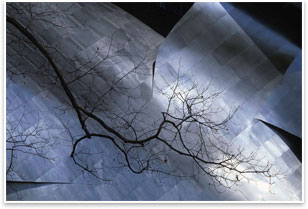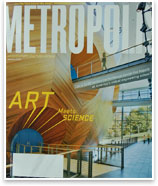|
AIA Honors Six for Collaborative Achievement
 Summary: Recognizing the collaborative contributions of two individuals, a photographer and an engineer; two publications, a textbook and a magazine; a preservation organization; and an essay competition, the AIA announced the 2009 Collaborative Achievement Awards on January 22. Summary: Recognizing the collaborative contributions of two individuals, a photographer and an engineer; two publications, a textbook and a magazine; a preservation organization; and an essay competition, the AIA announced the 2009 Collaborative Achievement Awards on January 22.
 The AIA awards the Institute Honors for Collaborative Achievement to encourage distinguished achievements of allied professionals, clients, organizations, architect teams, knowledge communities, and others who have had a beneficial influence on or advanced the architectural profession. The AIA awards the Institute Honors for Collaborative Achievement to encourage distinguished achievements of allied professionals, clients, organizations, architect teams, knowledge communities, and others who have had a beneficial influence on or advanced the architectural profession.
Peter Aaron
The master contributing photographer for Esto Photographics served early in his architectural photography career as an apprentice to Ezra Stoller, notes John Belle, FAIA, RIBA, in his letter of nomination. Aaron “adapted and built upon his master’s techniques and began integrating dramatic camera angles with theatrical lighting,” Belle writes.
 More recently, Aaron has transitioned his techniques to digital photography, adds Joel Sanders, AIA, in his letter of support: “Peter instantly saw the potential of digital photography to enhance the implementation of techniques he first developed using old-school large-format cameras. As a consequence, his recent body of work brings together the mature eye of a seasoned veteran with the vibrancy and freshness of a younger generation of digitally inclined practitioners.” More recently, Aaron has transitioned his techniques to digital photography, adds Joel Sanders, AIA, in his letter of support: “Peter instantly saw the potential of digital photography to enhance the implementation of techniques he first developed using old-school large-format cameras. As a consequence, his recent body of work brings together the mature eye of a seasoned veteran with the vibrancy and freshness of a younger generation of digitally inclined practitioners.”
“He is an expert observer,” adds Robert A.M. Stern, FAIA, in his recommendation. “He does not simply record work; he interprets it, helping all of us, including the architects of the buildings he photographs, to understand what has been created.”
 The Architecture Handbook The Architecture Handbook
Drafting students in Chicago high schools had been using a text authored in 1951 until, only two years ago, a joint effort of Chicago Public Schools and the Chicago Architecture Foundation produced The Architecture Handbook: A Student Guide to Understanding Buildings, by Jennifer Masengarb with Krisann Rehbein. The guide, along with its accompanying CD and a teachers’ edition, came together via a collaborative process including educators, practitioners, and students and reaches well beyond the mechanics of CAD and BIM skills.
“The book refocuses emphasis away from strictly acquiring technical drawing skills and towards the application of those skills in the service of studying the design process, architectural history, preservation, geography, urban studies, and sociology to explore the built environment,” writes Peter G. Ellis, FAIA, RIBA in support of the nomination.
Fariha Wajid, a Chicago high school student who was among the first to use the new text book also writes in support: “The Handbook has been a great motivation for me to pursue my dream of becoming a successful architect, one who will not only design aesthetically, but will also consider the beneficial factor in helping humankind live economically and sustainably.” The book is now in use throughout Chicago and finding its way into high school curriculums nationwide.
 Guy Nordenson Guy Nordenson
Beginning his studies at MIT in literature and philosophy, Guy Nordenson soon began forging a miraculous course into structural engineering, later working with architect luminaries, Leslie Robertson points out in his letter of recommendation, such as Harry Cobb, Herzog et de Meuron, Stephen Holl, Rem Koolhaas, Michael Maltzan, Richard Meier, Eric Moss, Renzo Piano, James Polshek, Yoshio Taniguchi, and TEN Arquitectos.
Harking back to many of the great post-war engineers of the 1960s, Nordenson has melded the roles of practitioner and educator. In addition to Robertson and Isamu Noguchi, Norenson’s early career was shaped by the likes of R Buckminster Fuller, Mathys Levy, and Mario Salvadori.
“Nordenson’s admirable comprehension of cultural issues, far beyond the specifics of engineering is demonstrated in his appointment to New York City’s Art Commission, his position at Princeton University’s Center for Human Values, and his co-curatorship of a Museum of Modern Art exhibit on Tall Buildings,” writes John Morris Dixon, FAIA, in his nomination. “Guy is not just a great engineer,” writes Steven Holl, AIA, “he is an intellect and a teacher of the most inspirational type.”
Nordenson and the organization he helped co-found to study seismic design in New York, the Structural Engineers Association of New York, proved instrumental in the weeks following the attacks of 9/11/01 in assessing the damage to buildings in Lower Manhattan, closing those unsafe and opening back those still sound.
 Metropolis Metropolis
Both publisher for 27 years of the magazine that addresses every area of design—architecture, interior design, planning, landscape architecture, technology, industrial design, and graphic design—and, for three years, of an impressive array of books, “Metropolis was and is a magazine for and about architects but it is clearly also a magazine for lovers of architecture and design,” writes Mike Mense, FAIA, in his letter of nomination.
“Susan [Szenasy, editor in chief] and Metropolis have used their forum to educate the public and the profession on the values of good design and innovative ways to achieve our goals,” writes Eva L. Maddox, Assoc. AIA, in her letter of support. “Her influence also reaches manufacturers who value her directness, support, and expectation that their products meet the needs of architects and designers today and are eco-friendly.”
“The magazine is well researched, illuminating, beautifully designed, and fresh,” writes Peter Busby, AIA. “They uncover new trends and ideas on a regular basis. They reach across broad cross sections of design disciplines, which mirrors our own interdisciplinary design approach. Metropolis has stimulated our architects and designers for years.”
DOCOMOMO US
Affiliated with more than 50 parallel organizations worldwide, DOCOMOMO US is dedicated to the documentation and conservation of buildings, sites, and neighborhoods of the Modern movement. John Morris Dixon, FAIA, on behalf of the AIA Committee on Design, nominated the organization for its vigorous and effective work to publicize Modern landmarks, document key works for archives, and researching and disseminating preservation techniques particular to Modern buildings.
“DOCOMOMO US, with its diverse membership of architects, preservationists, historians, and enthusiasts, has become both a recognized force and a respected name in the preservation of Modern heritage in the U.S.,” lauds MoMA Philip Johnson Chief Curator Barry Bergdoll. “In its 10 years of official existence … it has become a leader in the preservation of Modern architecture in the U.S., and, with its more than 10 regional and local chapters, it forms a bridge between the international, national, and local communities ... The organization was and continues to be integral to the preservation efforts of such major icons as New York’s TWA Terminal, Boston’s City Hall, or Aalto’s Library at Harvard, and regionally significant landmarks as Seattle’s Monorail or Park Merced in San Francisco.”
“DOCOMOMO US is an important presence in the international and national preservation and architectural community,” writes DOCOMOMO International Chair Maristella Casciato, “and continues to promote a constructive dialogue with building owners, developers, and designers in many disciplines both in the U.S. and in the world community at large and proves that the preservation of Modern architecture plays an important role in the design community today.”
 Berkeley Prize Berkeley Prize
“Through a two-stage juried process, the [Berkeley Undergraduate Prize for Architectural Design Excellence] encourages, promotes, and rewards critical thinking and writing—two traditionally underemphasized areas of architectural education and training,” writes John Cary, Assoc. AIA, in his letter of nomination. To date, he writes, the annual competition, founded by UC Berkeley Professor Raymond Lifchez, has drawn submissions from 893 architecture students in 45 countries.
Embracing the idea that social ideals are fundamental to making buildings of worth, the prize is made possible within the Department of Architecture of the College of Environmental Design at the University of California, Berkeley, by an endowment from the late poet, teacher, and journalist Judith Lee Stronach. Each year, the endowment awards about $10,000 in prizes.
“The Berkeley Prize is a remarkable initiative—one that has attracted and mobilized an array of participants from around the world,” writes James P. Cramer, Hon. AIA, in support. “What started as a humble exchange of ideas shows the makings of a movement. That movement or idea—that architecture is a social art—speaks to the best values of our profession.”
“Our initiative would not have been possible without the collaborative model provided to us by the Berkeley Prize Competition,” writes ArchVoices Essay Competition Chair Matt Ostanik, AIA. “The Berkeley Prize Competition has successfully elevated the importance of the written word, especially to such a critical group as architecture students. [It has] sought to move beyond written reflection that is solely by architects for architects, but instead has reached outside of the profession to explore the social impact of architecture in a truly global context.” |




 More recently, Aaron has transitioned his techniques to digital photography, adds Joel Sanders, AIA, in his letter of support: “Peter instantly saw the potential of digital photography to enhance the implementation of techniques he first developed using old-school large-format cameras. As a consequence, his recent body of work brings together the mature eye of a seasoned veteran with the vibrancy and freshness of a younger generation of digitally inclined practitioners.”
More recently, Aaron has transitioned his techniques to digital photography, adds Joel Sanders, AIA, in his letter of support: “Peter instantly saw the potential of digital photography to enhance the implementation of techniques he first developed using old-school large-format cameras. As a consequence, his recent body of work brings together the mature eye of a seasoned veteran with the vibrancy and freshness of a younger generation of digitally inclined practitioners.” The
The  Guy Nordenson
Guy Nordenson Metropolis
Metropolis Berkeley Prize
Berkeley Prize